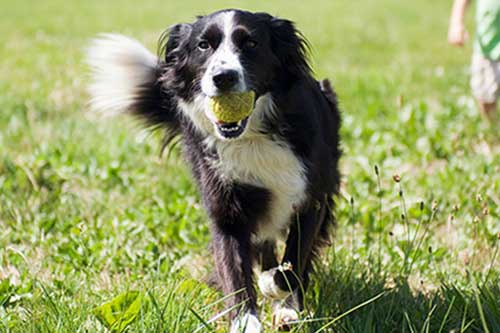
By Susan Breslow, former Head of Publications for the ASPCA and the author of the children's book "I Really Want a Dog."
Is your dog a bundle of energy or a canine couch potato?
Puppies seem to be made of fur and kinetic energy, mature ones settle into a routine and senior dogs slow down. Yet regardless of the age or size of a dog, they all need physical activity to reduce anxiety, combat boredom and maintain good mental and physical health.
Any exercise routine should reflect your dog's age and condition. And do keep your dog hydrated by carrying a portable bowl and water.
Weather should be a factor when it comes to exercising your dog. Like humans, canines are susceptible to heat stroke when the temperature and humidity soar, as well as frostbite when the thermometer plummets. Short-haired dogs benefit from wearing a coat in the cold. Also, paws should be inspected after every outing for cuts, nail condition and damage from salt in winter.
To determine the right kind of exercise for your dog, consider her breed (if yours is a mix, focus on her dominant breeds). Not every dog is the same, so be sure to select a dog that matches the amount of exercise that you can give them.
Bred for jobs that require endurance, these groups have the greatest need for a daily workout. They include Retrievers, Spaniels, Collies, Pointers and German Shepherds. Include training along with exercise and vary routines to keep the attention of these robust dogs.
Smaller and medium-sized sporting dogs such as Border Collies, Shelties, and Australian Shepherds excel at activities like agility that challenge their intelligence and obedience as well as their muscle.
Energetic Terriers — a group that includes everything from little Westies to Schnauzers of all sizes—need almost as much exercise as sporting or herding dogs. Two hours a day of fun exercise will keep them in good condition. They also benefit from toys and mentally stimulating interaction.
This group ranges from loping Bassets to perky Beagles to muscular Greyhounds. Because the dogs in this class are so varied, their exercise needs depend on their size, age and general fitness level. As with all breeds, it's wise to ask your veterinarian about the type and duration of exercise that suits your dog.
Flat—faced dogs like Pugs and Bulldogs are prone to both respiratory problems and obesity -they still need exercise but shouldn't be over taxed. The way these breeds are built puts them at risk for overheating. Their activities should be limited to a small area and curtailed in hot weather. Similarly, dogs with heavy coats, including Siberian Huskies, Alaskan Malamutes, Old English Sheepdogs and Komondors thrive in winter's chill.
Having a dog whose energy level matches yours is ideal. Dogs that love to run and play for extended periods are great for active pet parents. Breeds well suited for joggers include Boxers, German Shorthaired Pointers, English Setters, Brittany Spaniels, Vizslas, Dalmatians and even pint-sized Jack Russell Terriers.
Older dogs may no longer be able to run as far, jump as high and maintain their balance as when they were young. Their reduced activity requirements make them good companions for people who aren't especially active. Senior dogs, lap dogs and toy breeds may be a good match for them. Although older dogs do not require a lot of activity, they still need light daily exercise and a good walk. Make sure to check with your veterinarian to make sure your senior dog has the appropriate exercise regime based on their health and age.